
The Philippine naked-backed fruit bat or Philippine bare-backed fruit bat is a megabat that mostly lives on Negros Island. Two small populations were also found on Cebu Island in the Philippines. Like other bare-backed fruit bats, its wings meet along the midline of their bodies, making it a very agile flier. It roosted in caves, in areas where little light penetrated the gloom. It was so abundant once that it left piles of guano, which were used by miners as fertilizer.

The Mariana fruit bat, also known as the Mariana flying fox, and the fanihi in Chamorro, is a megabat found only in the Mariana Islands and Ulithi. Habitat loss has driven it to endangered status, and it is listed as threatened by the US Fish and Wildlife Service. Poachers and food hunters, other animals, and natural causes have led to the decline.

The long-tongued nectar bat, also known as the northern blossom bat, honey nectar bat, least blossom-bat, dagger-toothed long-nosed fruit bat, and lesser long-tongued fruit bat, is a species of megabat. M. minimus is one of the smallest species in the family Pteropodidae, with an average length of 60–85 mm. It has a reddish-brown colouring with relatively long hair compared to the other species. The hair on the abdomen is a lighter colour, and a dark brown stripe runs bilaterally down the top of the head and back.
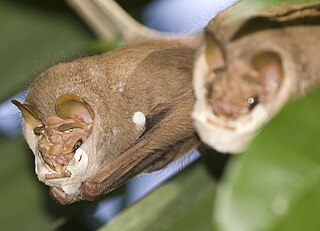
The wrinkle-faced bat is a species of bat in the family Phyllostomidae and the only identified member of the genus Centurio. This bat is found in various countries in and around Central America. It eats fruit but is not classified within the fruit bats, and is instead classified as a leaf-nosed bat even though it does not have a leaf nose. It has an unusually shaped skull which is thought to allow it to eat a wider range of foods than other bats.

The greater musky fruit bat is a species of megabat in the family Pteropodidae. It is endemic to the Philippines. It was named by Peters for Fedor Jagor.
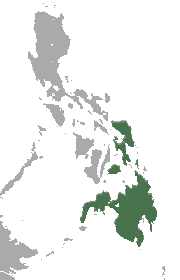
The lesser musky fruit bat is a species of megabat in the family Pteropodidae. It is endemic to the Philippines.

The Ryukyu flying fox or Ryukyu fruit bat is a species of megabat in the family Pteropodidae. It is found in Japan, Taiwan, and the Batanes and Babuyan Islands of the Philippines. Its natural habitats are subtropical or tropical dry forests and subtropical or tropical swamps. It is threatened by habitat loss and by hunting for food and the IUCN classify it as "Vulnerable".
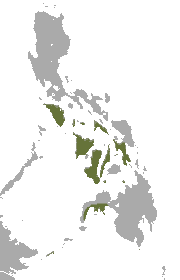
The little golden-mantled flying fox is a species of bat in the family Pteropodidae. It is found in Indonesia and the Philippines. Its natural habitat is subtropical or tropical dry forests. It is threatened by hunting and habitat loss, as well as pollution.
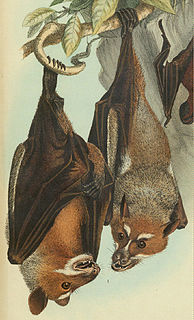
Styloctenium is a genus of stripe-faced fruit bat in the Pteropodidae or (megabat) family. It comprises the following species:
The Mindoro stripe-faced fruit bat, nicknamed the "flying fox" for its foxlike face, is a species of large Philippine megabat. It is endemic to the island of Mindoro. The Mindoro stripe-faced fruit bat ranked sixth in the top ten species of 2008, selected by the International Institute for Species Exploration.
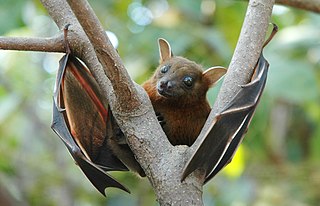
The lesser short-nosed fruit bat is a species of megabat within the family Pteropodidae. It is a small bat that lives in South Asia and Southeast Asia. It weighs between 21 and 32 grams, and/or 70 to 127 mm. It occurs in many types of habitat, but most frequently in disturbed forest, including lower montane forest and tropical lowland rain forest, plus gardens, mangroves, and vegetation on beaches.

The Visayas State University is a university located in the city of Baybay, province of Leyte, Philippines. The five-campus VSU system has eight colleges, three institutes and one school. Located in the main campus are the College of Veterinary Medicine, College of Engineering, College of Education, College of Forestry and Environmental Science, College of Arts and Science, College of Nursing, College of Management and Economics, College of Agriculture and Food Sciences, Institute of Strategic Research and Development Studies, and the Graduate School and Special Programs.

Ficus septica is a shrub or tree of the family Moraceae living at low altitudes from northeast India to north Australia (Queensland), and throughout Malesia. It lives on the edge of the vegetation, often in degraded environments. The seeds of this species are dispersed by numerous species, including fruit bats (Megachiroptera) when present.

Andreas Fedor Jagor was a German ethnologist, naturalist and explorer who traveled throughout Asia in the second half of the 19th century collecting for Berlin museums.

Ficus variegata is a well distributed species of tropical fig tree. It occurs in many parts of Asia, islands of the Pacific and as far south east as Australia. There is a large variety of local common names including common red stem fig, green fruited fig and variegated fig. A non strangling fig which may reach 30 metres in height. The tree is evergreen when young but becomes briefly deciduous as it grows older. In Australia the fruit are eaten by cassowaries and double-eyed fig parrots.

Bats are eaten by people in parts of some Asian, African, Pacific Rim countries and cultures, including China, Vietnam, Seychelles, the Philippines, Indonesia, Palau, Thailand, and Guam. Half the megabat species are hunted for food but only eight percent of the insectivorous bat species are. In Guam, Mariana fruit bats are considered a delicacy.
University of the Philippines Arboretum, also known as UP Arboretum, is a botanical garden located on the campus of the University of the Philippines Diliman in Quezon City, Philippines. It lies at the northern part of the village of U.P. Campus between the U.P.-Ayala Land TechnoHub on Commonwealth Avenue to the south and Central Avenue and the village of Culiat to the north, close to the Philippine Nuclear Research Institute. The 16-hectare (40-acre) man-made forest garden houses a collection of more than 9,000 tropical plants of about 77 unique species. It is one of few rainforests of its size located entirely within Metro Manila.
The subfamily Cynopterinae comprises 24 species of pteropodid bats distributed exclusively in South and Southeast Asia.















